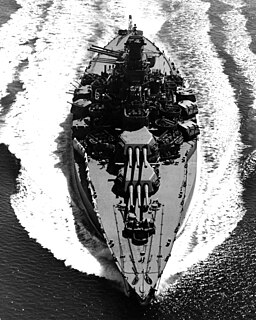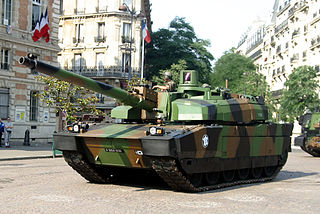A turret gun is a type of multi-shot hand-held firearm. It is a variation on the percussion revolver, designed with chambers in a drum mounted so it would rotate horizontally (around a vertically mounted pivot), rather than around a horizontal axis, in an attempt to circumvent the patent of Samuel Colt. Chambers opened in all directions, and the weapon was prone to row ignition, all chambers firing in sequence, resulting in fatal accidents because one chamber always faces the shooter.
Several designs were attempted, including an 1837 Cochran and an 1851 Porter.
A number of turret rifles were also attempted. None of these weapons were successful, due to the row-firing hazard. As a result, they are very rare and much sought-after.

A broadside is the side of a ship, or more specifically the battery of cannon on one side of a warship or their coordinated fire in naval warfare, or a measurement of a warship's maximum simultaneous firepower which can be delivered upon a single target. From the 16th century until the early decades of the steamship, vessels had rows of guns set in each side of the hull. Firing all guns on one side of the ship became known as a "broadside". The cannon of 18th-century men of war were accurate only at short range, and their penetrating power mediocre, which meant that the thick hulls of wooden ships could only be pierced at short ranges. These wooden ships sailed closer and closer towards each other until cannon fire would be effective. Each tried to be the first to fire a broadside, often giving one party a decisive headstart in the battle when it crippled the other ship.

The Tennessee class consisted of two super-dreadnought battleships—Tennessee and California—built for the United States Navy in the late 1910s, part of the "standard" series. The class was in most respects a repeat of the preceding New Mexico class, with the primary improvements being a significantly strengthened underwater protection system, and increased elevation of the main battery guns to allow them to fire at much greater ranges. They carried the same main battery of twelve 14-inch (356 mm) guns in four triple turrets, and had the same top speed of 21 knots. Both ships served in the Pacific Fleet for the duration of their careers, which included an extensive training program during the interwar period of the 1920s and 1930s.

The T-35 was a Soviet multi-turreted heavy tank of the interwar period and early Second World War that saw limited production and service with the Red Army. Often called a land battleship, it was the only five-turreted heavy tank in the world to reach production, but proved to be slow and mechanically unreliable. Most of the T-35 tanks still operational at the time of Operation Barbarossa were lost due to mechanical failure rather than enemy action. It was designed to replace the T-28 at the time; however, very few were built.

Schräge Musik, which may also be spelled Schraege Musik, was a common name for the fitting of an upward-firing autocannon or machine gun, to an interceptor aircraft, such as a night fighter. The term was introduced by the German Luftwaffe during World War II. "Schräge Musik" was previously a German colloquialism, meaning music that featured an unusual tuning and/or time signature. By itself, the word Schräge has often been translated as "slanting" or "oblique", although it may instead be rendered into English as "weird" or "strange".

The Leclerc tank is a main battle tank (MBT) built by GIAT, now Nexter of France. It was named in honor of General Philippe Leclerc de Hauteclocque, who led the French element of the drive towards Paris while in command of the Free French 2nd Armoured Division in World War II. The designation "AMX-56" – while very popular – is incorrect.

The Nelson class was a class of two battleships of the British Royal Navy, built shortly after, and under the terms of, the Washington Naval Treaty of 1922. They were the only British battleships built between the Revenge class and the King George V class, ordered in 1936.

The Nevada class comprised two dreadnought battleships—Nevada and Oklahoma—built for the United States Navy in the 1910s. They were significant developments in battleship design, being the first in the world to adopt "all or nothing" armor, a major step forward in armor protection because it emphasized protection optimized for long-range engagements before the Battle of Jutland demonstrated the need for such a layout. They also introduced three-gun turrets and oil-fired water-tube boilers to the US fleet. The two Nevadas were the progenitors of the standard-type battleship, a group that included the next four classes of broadly similar battleships that were intended to be tactically homogeneous.

The Type 90 tank is a main battle tank (MBT) of the Japan Ground Self-Defense Force (JGSDF). It was designed and built by Mitsubishi Heavy Industries as a replacement for the Type 61 and to supplement the then current fleet of Type 74 tanks, and entered service in 1990. It is to be superseded by the Type 10 tank.

Turret ships were a 19th-century type of warship, the earliest to have their guns mounted in a revolving gun turret, instead of a broadside arrangement.

A revolver cannon is a type of autocannon, commonly used as an aircraft gun. It uses a cylinder with multiple chambers, like those of a revolver handgun, to speed up the loading-firing-ejection cycle. Some examples are also power-driven, to further speed the loading process. Unlike a rotary cannon, a revolver cannon has only a single barrel, thus its spun weight is lower. Automatic revolver cannons have been produced by many different manufacturers.

Naval artillery is artillery mounted on a warship, originally used only for naval warfare and then subsequently used for shore bombardment and anti-aircraft roles. The term generally refers to tube-launched projectile-firing weapons and excludes self-propelled projectiles such as torpedoes, rockets, and missiles and those simply dropped overboard such as depth charges and naval mines.

A gun turret is a mounting platform from which weapons can be fired that affords protection, visibility and ability to turn and aim. A modern gun turret is generally a rotatable weapon mount that houses the crew or mechanism of a projectile-firing weapon and at the same time lets the weapon be aimed and fired in some degree of azimuth and elevation.

A pivot gun was a type of cannon mounted on a fixed central emplacement which permitted it to be moved through a wide horizontal arc. They were a common weapon aboard ships and in land fortifications for several centuries but became obsolete after the invention of gun turrets.

The United States military has developed a number of Helicopter Armament Subsystems since the early 1960s. These systems are used for offensive and defensive purposes and make use of a wide variety of weapon types including, but not limited to machine guns, grenade launchers, autocannon, and rockets. Various systems are still in use, though many have become obsolete.

Gun laying is the process of aiming an artillery piece or turret, such as a gun, howitzer, or mortar, on land, in air, or at sea, against surface or aerial targets. It may be laying for direct fire, where the gun is aimed similarly to a rifle, or indirect fire, where firing data is calculated and applied to the sights. The term includes automated aiming using, for example, radar-derived target data and computer-controlled guns.

The Type 1936A destroyers, also known as the Z23 class, were a group of fifteen destroyers built for the Nazi Germany's Kriegsmarine from 1938 to 1943. They were known to the Allies as the Narvik class. In common with other German destroyers launched after the start of World War II, the Narviks were unnamed, known only by their hull numbers – Z23 to Z39.

The Iowa-class battleships are the most heavily armed gunships the United States Navy has ever put to sea, due to the continual development of their onboard weaponry. The first Iowa-class ship was laid down in June 1940; in their World War II configuration, each of the Iowa-class battleships had a main battery of 16-inch (406 mm) guns that could hit targets nearly 20 statute miles (32 km) away with a variety of artillery shells designed for anti-ship or bombardment work. The secondary battery of 5-inch (127 mm) guns could hit targets nearly 9 statute miles (14 km) away with solid projectiles or proximity fuzed shells, and was effective in an anti-aircraft role as well. Each of the four battleships carried a wide array of 20 mm and 40 mm anti-aircraft guns for defense against enemy aircraft.
A weapon mount is an assembly or mechanism used to hold a weapon onto a platform in order for it to function at maximum capacity. Weapon mounts can be broken down into two categories: static mounts and non-static mounts.
The Canon de 130 mm Modèle 1932 and 1935 were medium-caliber naval guns used as the primary armament on a number of French Navy destroyers and as dual-purpose secondary armament on battleships during World War II.
The 152 mm /53 Model 1926–1929 were built for the Italian Navy in the years before World War II. These guns were used on all Condottieri-class light cruisers except the Duca degli Abruzzi-class.